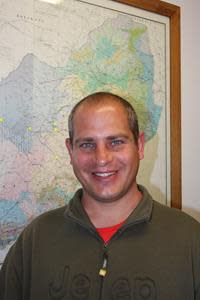The unseen, unsung heroes of our threatened grasslands
According to researchers from the University of the Free State (UFS) in South Africa, walking through grasslands one often ignores what is under our feet, but these creatures are vitally important for the wellbeing of any ecosystem
Prof Charles Haddad

Prof Charles Haddad, from the Department of Zoology and Entomology, in the Faculty of Natural and Agricultural Sciences at the University of the Free State (UFS),
Prof Liesl van As

Prof Liesl van As, Head of the Department of Zoology and Entomology at the UFS says that although the Grassland biome covers an area of 339 237 km2, less than 2% is formally protected.
Bloemfontein, Dec. 08, 2021 (GLOBE NEWSWIRE) -- In the vast, flat grasslands of South Africa a host of magnificent plant and animal species flourish, but not all of them are large. Insects and spiders share the landscape, and they are sometimes the uncelebrated heroes of a fragile ecology.
Walking through grasslands one often ignores what is under our feet, but these creatures are vitally important for the wellbeing of any ecosystem.
Grasslands are the dominant vegetation in the central parts of the country, covering most of the Free State and Gauteng and large parts of the North West, Mpumalanga, KwaZulu-Natal and the Eastern Cape, explains Prof Charles Haddad from the Department of Zoology and Entomology in the Faculty of Natural and Agricultural Sciences at the University of the Free State (UFS).
Insects fulfil a myriad of ecosystem functions and deliver crucial services in grasslands. They are the most important group of pollinators, such as bees, flies, and beetles, and are critical to the breakdown of plant and animal waste, especially flies and beetles. They are predators and parasites of other invertebrates, especially spiders, beetles, wasps and flies. The more species in an ecosystem, the greater the number of interacting organisms that can contribute to food webs.
Unfortunately, grasslands are the most threatened biome in South Africa, largely as a consequence of historical agricultural expansion of crop and livestock farming. More recently, urban development, invasive plants and silviculture have impacted on the remaining natural grasslands.
“Little is known about the impact of these activities on terrestrial biodiversity. The presumption is that the destruction and fragmentation of natural grassland reduces the natural vegetation available to indigenous organisms. This creates problems for insects to find suitable plants to feed on, which has a negative impact on their predators and parasites.
“Most anthropogenic influences affect indigenous biodiversity negatively, with very few exceptions. Generally, it is exotic invasive species that benefit the most from disturbance, habitat changes or destruction,” says Prof Haddad.
Spiders
More than 900 species of spiders have been recorded in our grasslands and some 2 300 in the country. Spiders are predators of other invertebrates, especially insects, and play an important role in the natural control of their populations.
They are very resilient to disturbance, but are susceptible to chemicals used on crops, the effects of alien plants, and competition with exotic spider species, says Prof Haddad.
Among the interesting spider species one can find in grasslands is a rich diversity of trapdoor spiders, which live in burrows in the ground. Many of them have narrow associations with specific soil types and are often good bioindicators for conservation management.
Some plant-dwelling spiders are uniquely adapted to living on grasses and have slender, pale bodies to camouflage themselves on the stalks of grasses. In contrast, tree-dwelling spiders are often brown with tubercles on their bodies to blend in with the bark of trees to help them ambush their prey, says Prof Haddad.
Termites
Termites are some of the most populous animals on Earth, and the effects they have are most profound in the grasslands. Termites are one of the few animals that can break down cellulose from dead wood and grass. This is made possible through their symbiotic association with tiny microorganisms in their alimentary canal, such as protozoans and bacteria. The microorganisms secrete the enzyme cellulase, which the termites cannot produce themselves, allowing for the breakdown of cellulose in the ingested plant material and the release of the component nutrients for use by the termites. Therefore, these insects play an integral role in the reintroduction of nutrients from the dead plants into the soil.
This enables them to utilise the molecules in the grass that would have otherwise been inaccessible. Their faeces therefore contain broken-down nutrients that the roots of plants can absorb.
Many termite species live in underground nests that are great in aerating the soil. Others build large mounds which are extensions of the nests above the soil surface. These mounds, particularly those of the snouted harvester termites, are a familiar feature in most grassland landscapes in the country. These nests and mounds also offer shelter to other organisms, such as spiders, scorpions, lizards, snakes, millipedes, and various insects.
Termites are an important food source for enigmatic animals such as the aardvark and aardwolf, as well as some spiders and beetles, says Prof Haddad.
Mosquitoes
Liezl Whitehead, a master’s student in the Department of Zoology and Entomology at the UFS, explains the role of how even mosquitoes are essential.
Mosquitoes are vitally integrated into the ecosystem even as larvae, where they feed on aquatic microorganisms, thereby affecting species interactions and ecosystem dynamics within the aquatic habitat.
Adult mosquitoes feed on nectar as their main food source, and in the process also serve as plant pollinators. Many female mosquitoes do, however, require a blood meal for egg production, where they then transmit a multitude of pathogens. Interestingly, these pathogens play a vital role in the ecosystem, where they help to regulate host population sizes, thereby maintaining the integrity of the ecosystem.
“In recognising the significance of all forms of life, one also realises that mosquitoes play an essential role in the life cycle of numerous other organisms, including protozoans [single-celled microscopic organisms], nematodes [often referred to as roundworms, but they are not closely related to true worms], and mites that depend on mosquitoes for their development and dispersal.
The abundance and widespread nature of mosquitoes contributes to their significant role in the grassland food chain, where the larvae are consumed by countless aquatic organisms, including insects, fish and amphibians. The adults are consumed by a multitude of arthropods and vertebrates, including dragonflies, birds and bats.
“Their elimination from the ecosystem would thereby impact multiple processes within the ecosystem, affecting food webs, pollination and the presence of many other associated organisms,” Whitehead adds.
A vital food source, urgent protection needed
Prof Liesl van As, Head of the Department of Zoology and Entomology at the UFS says that although the Grassland biome covers an area of 339 237 km2, less than 2% is formally protected. In 2004, the National Spatial Biodiversity Assessment (NSBA) identified the Grassland biome as the most threatened habitat, with more than 30% already irreversibly transformed. A year later, the Grassland Biodiversity Spatial Priority Assessment identified 37% of the land as being important for conservation, and suggested that 12% needs to be under formal protection by 2028.
Most of the South African grassland literature refers to the almost 400 plant species, the 34 endemic mammals, and the dozen or so globally threatened bird species, with almost no mention to representatives of the Arthropoda (including spiders, termites and mosquitoes).
Invertebrates are the main components of faunal diversity in grasslands, playing substantial roles in ecosystem processes, including nutrient cycling, pollination, and being a vital food source in food webs (Die een se dood is die ander een se brood).
“These invertebrate communities are heavily dependent on plant diversity and production within a given ecosystem, but for some reason they don’t get the full recognition and attention compared to the larger animals. Maybe it is because they are not so visible due to their smaller size?
“A visit to www.grasslands.org.za and the Grassland Society of Southern Africa draws our attention towards the fact that although progress has been made in the awareness of the sensitivity of grassland habitats, gaps still exist concerning the biodiversity of the remaining natural fauna. To follow up on this, I am of the opinion that when it comes to invertebrates, such as the spiders, termites and mosquitoes we are now writing about, knowledge and public awareness (citizen science) is contributing to reducing this gap” says Prof Van As.
According to her, in their department, a number of colleagues from Animal Behaviour, Arachnology, Nematology, Applied Agricultural Entomology, Environmental Entomology and Dipterology, to name a few, have been involved in research projects for the past few decades, with a focus on the grassland area, closer to home. Through their effort and contributions, they are making a scientific difference.
Attachments
CONTACT: André Damons University of the Free state 0764932044 damonsad@ufs.ac.za Dr Nitha Ramnath University of the Free state 0814055177 ramnathn@ufs.ac.za


 Yahoo Finance
Yahoo Finance 